San Fernando Valley, Ventura County, Riverside chapters usher in the Year of the Dragon.
By P.C. Staff
“Aware of the responsibility to which I have been elected and conscious of the role which the Japanese American Citizens League must play in our community and our nation, I do swear that I will discharge the duties of my office conscientiously and to the best of my ability. I will continue to further the purposes and mission of the JACL and to serve my fellow citizens in this country, the United States of America.”
With that oath, JACL chapters across the nation have installed their respective officers and board members in recent weeks. Following is a report on installation luncheons of two Southern California JACL chapters: San Fernando Valley JACL, Ventura County JACL and Riverside JACL.
San Fernando Valley JACL
On a brilliantly sunny Jan. 21, the San Fernando Valley JACL chapter held its 82nd installation luncheon at the San Fernando Valley Japanese American Community Center in Pacoima, Calif. The program kicked off with taiko, courtesy of the SFV Taiko Group.
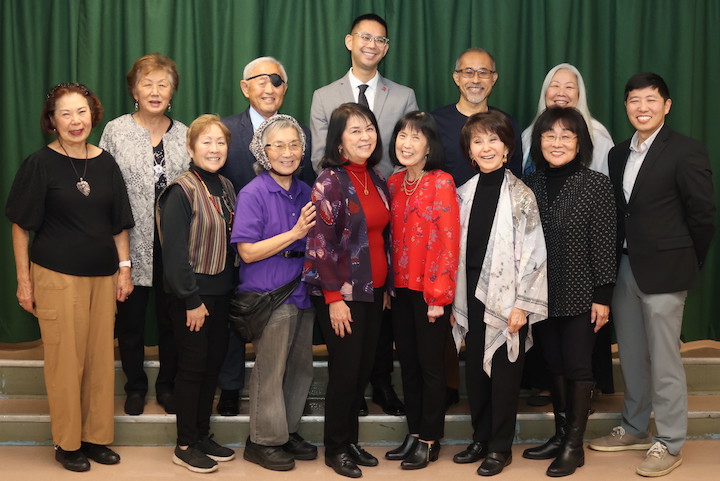
The 2024 San Fernando Valley JACL Chapter’s board of directors are, from left, back row: Nancy Gohata, Kiyo Fukumoto, Jean Paul deGuzman, Tomo Hattori, Nancy Takayama (outgoing president); and from left, front row: Geri Shiraki, Patty Takayama, Michiko Tokunaga Kus, Barbara Okita, Marcia Mahony, Linda Tanaka, May Wood (incoming president), PSW Gov. Ryan Yoshikawa (Photo: George Toshio Johnston)
The new board consists of May Wood, incoming president, with the remaining board of directors as follows: Linda Tanaka, Nancy Takayama (outgoing president), Marcia Mahony, Barbara Okita, Lana Kobayashi, Kiyo Fukumoto, Nancy Gohata, Jean-Paul deGuzman, Tomo Hattori, Michiko Tokunaga Kus, Mitzi Kushida, Geri Shiraki and Patty Takayama.
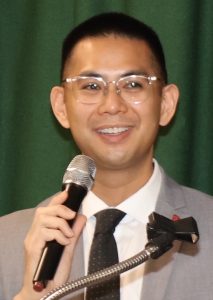
Jean Paul deGuzman serves as master of ceremonies at the Jan. 21 installation luncheon of the San Fernando JACL Chapter in Pacoima, Calif. (Photo: George Toshio Johnston)
The program began with a welcome by deGuzman, who introduced JACL Pacific Southwest District Gov. Ryan Yoshikawa, who later administered the JACL’s oath of office for the incoming board. Other special guests recognized by deGuzman included 2023 Nisei Week Queen Kaitlyn Emiko Chu, 2023 Miss Tomodachi Nancy Izumi Chin and 2022 Miss Tomodachi Maile Tabata Yanguas; Janice Tanaka, representing the Ventura County JACL; Kyoko Nancy Oda and Kay Oda, representing the San Fernando Valley Japanese American Community Center board; Rev. Paul Iwata, representing Sunrise Japanese Foursquare Church; Linnae McKeever, president, San Fernando Valley Hongwanji Buddhist Temple; Margaret Takimoto, chair, SFVJACC future planning committee; LAPD Foothill Division officers Jesse Ojeda and Esther Alvarez; and Kiyo Watanabe of the San Fernando Japanese Language Institute.
DeGuzman also introduced Ariel Imamoto, the current JACL Norman Y. Mineta Fellow, who shared with the audience the report of Pacific Southwest District Youth Representative Lana Kobayashi, who was unable to attend the installation. Nancy Takayama introduced the luncheon’s keynote speaker, Bill Watanabe.
He began with a quip. “They say that life is like a roll of toilet paper. It seems to go around faster as you get to the end,” Watanabe said to audience chuckles. “I know for me, it’s going around pretty quickly.”
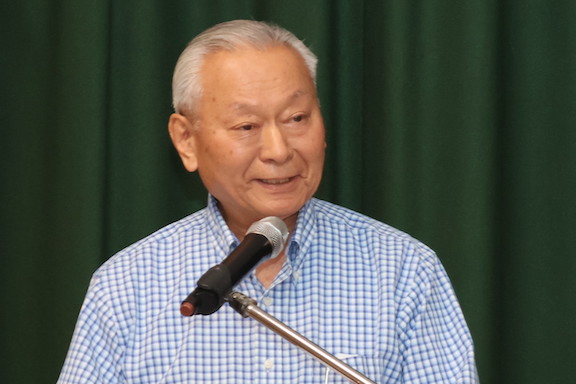
Bill Watanabe was the keynote speaker at the 2024 San Fernando Valley JACL installation luncheon on Sat., Jan. 21 at the San Fernando Valley Japanese American Community Center. (Photo: George Toshio Johnston)
Watanabe addressed his family’s experiences and exemplified the experiences and complicated differences within the Japanese American community that still resonate in the present. Prior to being removed from their home, his father and older brothers buried family heirlooms, including a katana, on the farmland they were leasing. Years later, they were unable to relocate what they had buried.
In his remarks, he noted that years before he would spend 31 years at the Little Tokyo Service Center as its founder and executive director — he retired in 2012 — he was a “San Fernando Valley boy” whose parents were farmers at the corner of “Laurel Canyon and Mountain View Street” on land owned by a Mr. Meichtry.
Watanabe praised Meichtry for driving from Pacoima to Manzanar to deliver “Mrs. Meichtry’s delicious fried chicken dinner” a couple of months after the Watanabes — along with thousands of other Nikkei families — were incarcerated at the Manzanar War Relocation Authority Center after World War II began. At his father’s request, Watanabe said Meichtry made a couple more trips to bring up some furniture to help furnish their barrack. “That’s the kind of guy that he was.”
Also, the Watanabes would be transferred to another concentration camp — Tule Lake — after his Issei father, who was ineligible to become a naturalized U.S. citizen and didn’t want to become “stuck without a country,” answered “no and no” to key questions on an infamous loyalty questionnaire.
Meantime, his Kibei Nisei mother, “who was a U.S. citizen, she didn’t know whether the family would be split apart from her husband and what would happen with the kids. So, she renounced her U.S. citizenship in the hopes of keeping the family together — and so, she was without a country because she was not a Japanese citizen.”
Watanabe also related how his mother had three brothers, two of whom joined the pro-Japan Hoshi Dan group and one, Tomio Fujiyama, who joined the 442nd Regimental Combat Team. “If they all got together over lunch during the war, it would have been interesting to be a fly on that wall” to hear that conversation, he speculated.
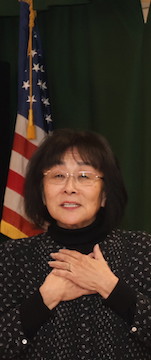
Incoming chapter president May Wood (Photo: George Toshio Johnston)
After the war ended and Watanabe’s parents contemplated moving to the Philippines, Brazil or Japan, some factors came into play that persuaded them to stay in America: a letter from Japanese relatives that essentially said, “Don’t come, it’s terrible here, we’re starving — and if you come, it’s going to be worse”; and a mentor to his father who acknowledged America’s flaws, but also noted that “America is also a land of great opportunity.”
“Then, the U.S. government did something positive,” Watanabe said. “The war in Europe just ended. So, the government told those Japanese who decided to go back to Japan that they could change their minds if they want to stay.”
They were eventually able to move back to their old place in Pacoima. “Our family was extremely lucky because of this man, Mr. Meichtry, who was very kind and generous and honorable. Many others were not so lucky. Many of the Japanese came back and all their property was stolen or destroyed, and they came back to nothing.”
Watanabe closed by encouraging those in the audience to work on a family history if they had not already done so. “If you still have grandparents or parents or uncles or cousins who might have some stories or recollections of your family here in the valley, it’d be good to record it and write it down,” he said.
After Yoshikawa administered the installation of the chapter’s new board, Nancy Takayama said a few words, reflecting on the past 20-plus years of her involvement with JACL and the Japanese American community and thanking all those who had helped her with during that time. She introduced the new chapter president, May Wood, who noted that JACL should not just move forward, but “move forward with love and compassion.”
With food and the formalities out of the way, it was time for some fun, via a game in which the audience was divided into teams and asked to identify the business or product based on a logo sans wording.
Ventura County JACL
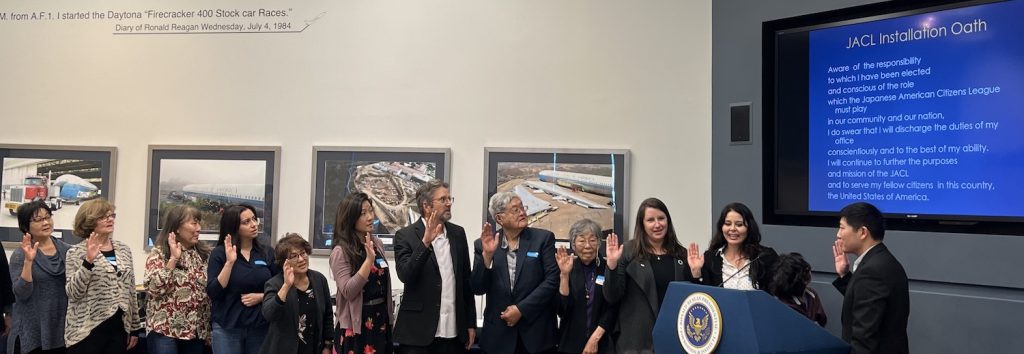
2024 Ventura County JACL board members (l-r): Ann Chilcott (secretary), Betty Katsura (book club coordinator), Akemi Ketchum, Samantha Wyllis-Quiñońez, Janice Tanaka, Jessica Wan (co-VP), Mark Chilcott, Ken Nakano (treasurer), Joanne Nakano, Megan Gately (co-president), Lily Tamai (co-president)and PSW Gov. Ryan Yoshikawa. Out of frame: Janice McCormick (co-VP) (Photo: George Toshio Johnston)
The Ronald Reagan Presidential Library and Museum in Simi Valley was again the site of the Ventura County JACL chapter’s 44th installation lunch, which took place on a blustery, cool Jan. 28.
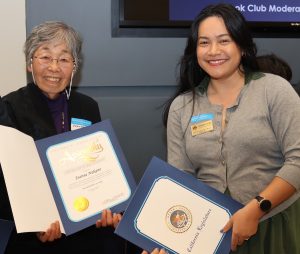
Joanne Nakano, left, displays the certificate of recognition presented on Jan. 28 by Michelle Sevilla, director of communications for Assemblymember Steve Bennett, District 38. (Photo: George Toshio Johnston)
PSW Gov. Ryan Yoshikawa administered the JACL Installation Oath to the incoming Ventura County JACL board, comprised of incumbents Megan Gately and Lily Anne Welty Tamai (co-presidents); Jessica Wan and Janice McCormick (co-vps); Anne Chilcott (secretary) and Ken Nakano (treasurer), who are also the cemetery restoration coordinators; Betty Katsura (book club coordinator); and Akemi Ketchum, Samantha Wyllis-Quiñońez, Janice Tanaka, Jessica Wan, Mark Chilcott and Joanne Nakano.
The luncheon’s guest speaker was Dean Kato, chairman of the California Strawberry Festival.
A special guest was Michelle Sevilla, the communications director for Assemblymember Steven Bennett of District 28. Following the installation ceremony, she gave out recognitions from Bennett’s office to the officers and incoming board members.
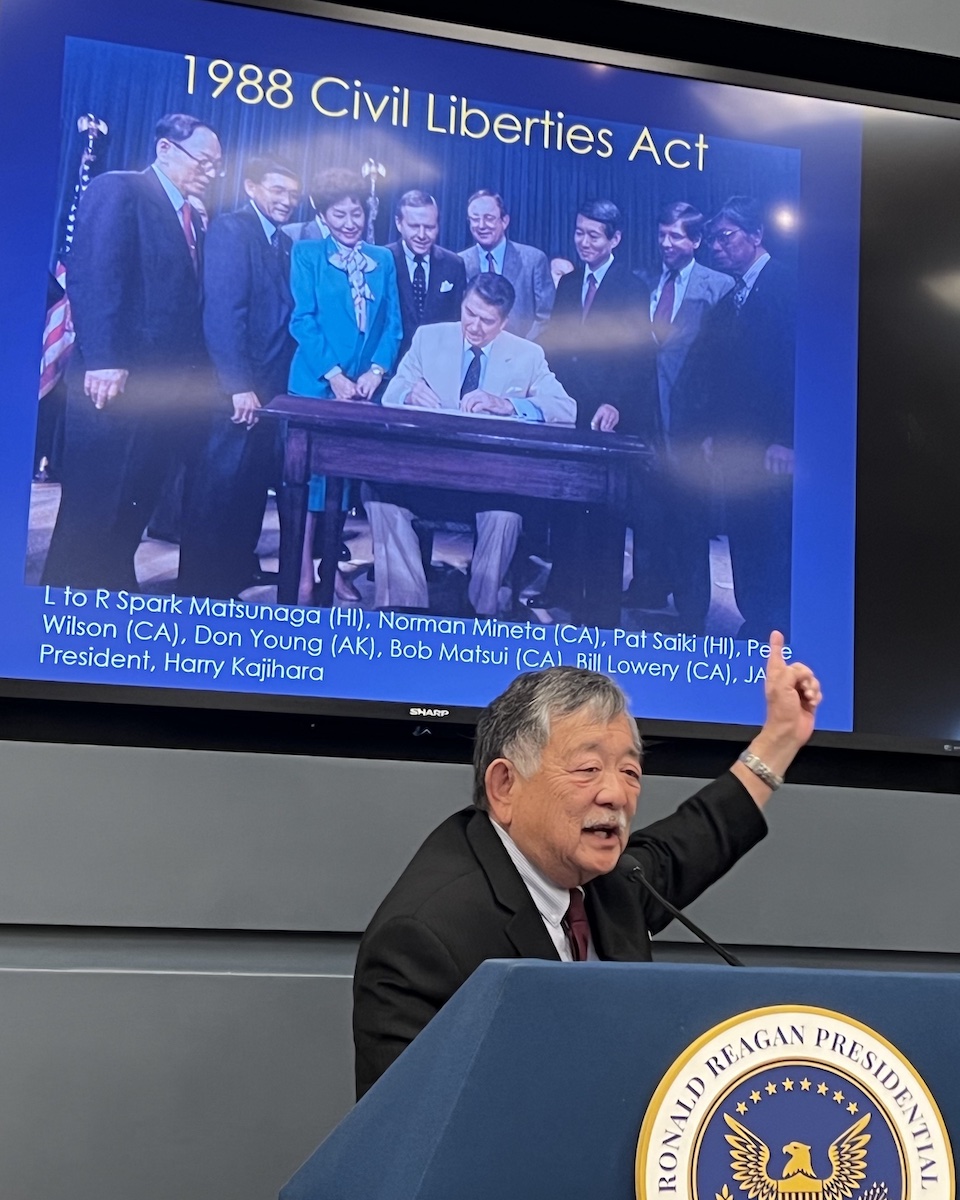
Ken Inouye shares an anecdote about the famous photo of President Reagan signing the Civil Liberties Act of 1988. (Photo: George Toshio Johnston)
Early in the luncheon, former JACL National President Ken Inouye, who has been a stalwart JACL member active with the SELANOCO JACL chapter for decades, went to the lectern and shared a short anecdote about the projected photo of President Reagan taken during the signing ceremony for HR 442, the Civil Liberties Act of 1988.
Pointing to the picture, he noted that standing next to the late Harry Kajihara, who was serving as JACL’s national president at the time, was Rep. Bill Lowery, a Republican who represented the San Diego area. Inouye recalled meeting with Lowery prior to the bill’s enactment by Reagan.
“When I said, ‘Would you pass the redress bill?’ he looked at me in the face, and he said, ‘I can’t. I don’t have enough of your kind in my district.’ ‘You don’t have enough Americans?’ He didn’t vote for the bill.”
That Lowery appeared in the picture was a mistake — “They invited the wrong guy,” Inouye said. Instead, it should have been Rep. Mike Lowry, a Democrat representing Washington state who was one of Congress’ early proponents for Japanese American redress and who later served as the state’s governor.
“So, when you see this picture, you’ll see a lot of historical Japanese American people, people that we all know and love. But there’s always that one ironic moment when you have somebody that shows up that just didn’t belong. I just wanted to share that with you,” Inouye said, garnering laughs from the audience.
“Seventy-five percent of the strawberries in America are from California,” Kato said. “Ninety-hour percent of households eat about five pounds of berries per year. I actually eat about 120 pounds.” He noted that “one cup of strawberries is only 55 calories” and that his favorite variety is the Albion.
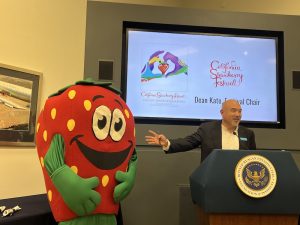
Berry, mascot of the California Strawberry Festival, and Dean Kato, festival chair, attend the Ventura County JACL Chapter installation luncheon on Jan. 28 at the Ronald Reagan Presidential Library. (Photo: George Toshio Johnston)
This year marks the fest’s 38th anniversary and will take place from 10 a.m.-7:30 p.m. on May 18 and 10 a.m.-6:30 p.m. on May 19 at the Ventura County Fairgrounds.
It will feature live bands and family-friendly entertainment on three stages, more than 75 food and beverage stands, more than 220 fine arts and crafts vendors, carnival rides, the Ninja Nation Obstacle Course, 15 novack food vendors and, of course, Berry, the festival’s mascot.
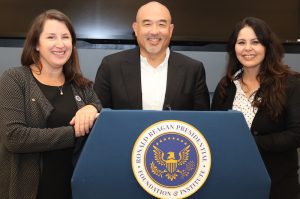
Ventura County JACL Chapter Co-Presidents Megan Gately and Lily Tamai flank guest speaker Dean Kato, chair of the California Strawberry Festival during the chapter’s installation luncheon on Saturday, Jan. 28 at the Ronald Reagan Presidential Library. (Photo: George Toshio Johnston)
“Everything costs more, as you know: water, tents, security — everything,” Kato noted. Although the price per-person of admission increased to $15 from $12, he said, “We still have a $5 strawberry shortcake.” Furthermore, he said that adopting technologies like DocuSign for behind-the-scenes necessities like getting contracts signed and using payment methods like PayPal, Venmo and Zelle have helped make processes more efficient. He also noted that because the fest’s site is now the Ventura County Fairgrounds and Event Center, it’s possible to take the Amtrak Pacific Surfliner, which stops near the Fairgrounds — and avoid the drive. (Visit https://castrawberryfestival.org/ for details and ticket information.)
Before wrapping up the event, Gately also noted that Rep. Julia Brownley, whose district encompasses most of Ventura certificates recognizing the Ventura JACL’s service. All the attendees were able to bring home bags of fresh, locally grown produce.
Rep. Mark Takano Installs Riverside JACL Officers, Board Members
Luncheon speaker Judge Yabuno discusses law career, Japanese American roots.
What’s rarer than 13-year-cycle and 17-year-cycle cicada broods emerging at the same time? How about having a member of the House of Representatives, who just happened to be attending your annual Riverside JACL installation as a guest, administer the oath of office to your chapter’s incoming officers and board?
Thanks to a scheduling conflict, that is exactly what happened on March 9 at the Riverside JACL chapter’s luncheon, held at the Cactus Cantina. With Pacific Southwest District Gov. Ryan Yoshikawa, who had been busy installing incoming JACL chapter officers and boards throughout Southern California, out of state for other JACL business, master of ceremonies Douglas Urata “deputized” Rep. Mark Takano (D-Calif.), who was in attendance, to take the reins.

Rep. Mark Takano, far right, administers the JACL’s oath of office to the Riverside JACL Chapter’s 2024 board of directors. From left: Akio Yoshikawa, Doug Urata, Jennifer Betancourt, Braeton Buckley, Michiko Yoshimura (seated), Beverly Inaba (standing), Helen Yoshikawa, Clyde Wilson, Meiko Inaba and Takano (Photo: George Toshio Johnston)
In actuality, perhaps having a visiting dignitary administer the oath of office to incoming JACL chapter leaders may not be quite as rare as the joint appearance of two disparate cicada broods — but Takano was not in the least bugged by the task, swearing in Michiko Yoshimura (president, scholarships), Beverly Inaba (vp), Dr. Clyde Wilson (treasurer), Helen Yoshikawa (recording secretary), Jennifer Betancourt (membership chair, youth adviser), Braeton Buckley (newsletter editor, youth adviser), Meiko Inaba (1000 Club), Taka Tanaka (civil liberties), Urata (PSWD delegate), Irene Ogata and Sara Morita (social media) and Akio Yoshikawa (member at large).
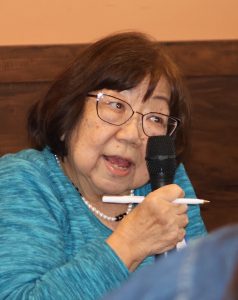
Riverside JACL Chapter President Michiko Yoshimura (Photo: George Toshio Johnston)
In her remarks as president for some 20 years, Yoshimura thanked Emily Sarashina for serving as the chapter’s representative to the University of California Riverside’s Nikkei Student Union. She also thanked Helen Yoshikawa for her work with the chapter’s scholarship committee. In addition, Yoshimura spoke about an upcoming event on May 1, when Highland Elementary School will be renamed Harada Elementary School, in honor of the Harada family and their successful legal battle over the right to own property at a time when California’s alien land law prevented noncitizens from doing so.
With that legal precedent in mind, it was fitting that Urata then introduced the afternoon’s speaker, the Hon. Judge R. Glenn Yabuno, immediate past presiding judge of the California Superior Court of San Bernadino County. His topic: “A Sansei’s Journey to the Bench.”
Raised in Fresno, Calif., Yabuno earned his undergraduate degree from California State University, Fresno, his J.D. from Santa Clara University School of Law and was admitted to the California State Bar in 1983. The next year, he joined the San Bernardino County District Attorney’s office. In 2010, he was appointed by then-Gov. Arnold Schwarzenegger to the bench with the Superior Court of San Bernardino County.
Yabuno highlighted one of the most important cases he was associated with, namely a deadly train derailment in the Cajon Pass caused by a faulty brake line. Serving as an example of how the law can be used to prevent such disasters from happening in the future, it was mandated that trains be equipped with “end of train” devices that allow an engineer to activate the brakes not just from the front but also from the rear in case of a kink in the brake line.
Regarding the size of jurisdiction of the Superior Court of San Bernardino County, Yabuno said, “Whether you’re aware of it or not, San Bernardino is the largest county in the 48 states. It’s a little over 20,000 square miles. It stretches from L.A. to the far west to the Arizona and Nevada borders to the east. Our furthest courthouse, which is the Needles courthouse, is four hours from downtown San Bernardino. Barstow is about an hour and change. We also have a courthouse in Joshua Tree.”
Regarding the changes he has witnessed in his career over the decades since moving from Fresno and initially joining the District Attorney’s office, Yabuno said, “I was the first Asian, let alone Japanese American, to work in the D.A.’s office. At that time, there was one Asian judge on the bench for the entire county.
“In 2010, I was a third Asian judge in our county. So, you know, we’ve come a long way,” Yabuno continued. “Both Riverside and San Bernardino have a lot more representation from the Asian community, as well as other communities. Gov. (Gavin) Newsom and Gov. (Jerry) Brown were very in tune with making sure that the population was represented.”
Yabuno pivoted to another topic that is one of his enthusiasms: genealogy. For Japanese Americans interested in tracing their family trees in Japan, he highlighted the necessity of obtaining one’s koseki, or official family register, maintained by local municipal offices in Japan. He also emphasized the importance of getting personal histories from family members. “I would encourage all of you to go back and get that part of history for your family before it’s too late. … Talk to your grandparents and your parents and everybody else and get those names,” he said.
On a related topic, Yabuno discussed how Japanese Americans whose relatives were incarcerated by the federal government during World War II could get those family records as well.
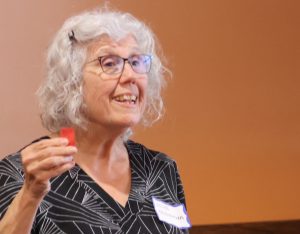
Helen Yoshikawa conducts the luncheon’s giveaway. (Photo: George Toshio Johnston)
“The National Archives has the War Relocation Authority records that you can access, and I just did that,” he said. “It’s amazing what you can find in those records that will be sent to you from the National Archives.” (Editor’s note: Yabuno left photocopies of Chester Hashizume’s “Discovering Your Japanese American Roots” and “References for Discovering Your Japanese American Roots” for luncheon attendees. Copies of the PDF of Hashizume’s documents may be downloaded at tinyurl.com/hahd8j9d and tinyurl.com/pys6rmk9.)
With the installation and speech completed, it was raffle time, conducted by Helen Yoshikawa. Among the prizes were bags of oranges grown in the Inland Empire. Alas, because of pest control protocols that had nothing to do with cicadas, they weren’t allowed to be brought into Los Angeles County.
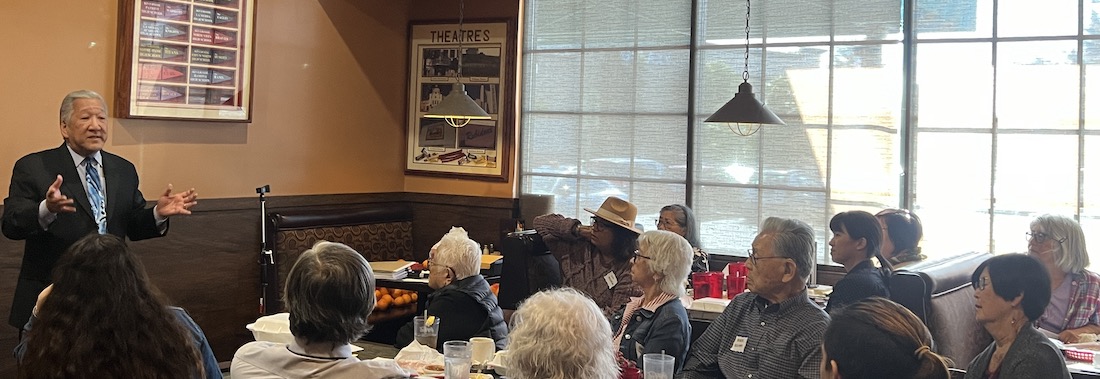
Judge Glenn Yabuno addresses Riverside JACL Chapter members on March 9 at the Cactus Cantina. (Photo: George Toshio Johnston)



